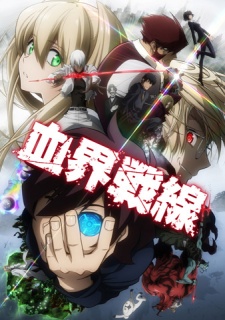
Watching Blood Blockade Battlefront is like listening to a great jazz piece; there’s a central theme, but it plays second fiddle to the crazy style, the reckless abandon of the instruments all vying for attention, the small sections of improvisation where we see the individual characters in the performance shine through. Sure, nothing much gets accomplished by the end of it. I probably couldn’t tell you any of the details of the plot of Blood Blockade Battlefront, but I could sure as hell quote it for days. It's infinitely rewatchable, because the whole experience lies in the absurd setting told through a brilliantly controlled cinematic style. I might even have enjoyed it more by tossing the plot to the winds and watching the episodes in a completely random order; I guess I’ll try that for my inevitable rewatch.
True to the jazz metaphor, the setting is a slightly retro New York City, and the soundtrack flits from hard jazz to blues to bombastic classical music, all of which serve not to heighten the drama or tension on screen, but rather to play off whatever crazy antics may be distracting us from any sense of drama or tension in the first place. After an unexplained incident caused monsters to begin flooding into New York City, a group of modern-day magic users sealed a part of the city off within a thick cloud of fog, containing the damage and monsters to a small radius downtown dubbed Hellsalem Lot, where for three years now they have lived in harmony with humans, creating a surreal paradise of racial and cultural meshing. Three-headed slime creatures go to the corner diner for a burger, TV anchors of all shapes and sizes talk about the latest crimes and fashion; for the residents of Hellsalem Lot this is the new normal, albeit with high tension as debacles and other incidents ensure a constant stream of explosions and projectile debris among other issues, keeping life from ever getting boring.
We specifically follow a human named Leonardo, who is normal other than having augmented eyes given to him by a god at the time of the incident that created Hellsalem Lot, which allow him to see invisible and faraway objects. Early on this causes him to get recruited by a secret peacekeeping force consisting of a drunken jerk who can form his blood into blades, a monstrously strong but polite wolf-looking man, an agile disappearing woman, and a whole other host of ragtag humans with an assortment of special combat abilities. Frankly, Leo is well out of his element, as both he and everyone on the team fully admits, and so as a protagonist he is perfect for narrating their thrilling but hilarious adventures within the city. Most episodes are episodic to that effect, but when Leo meets a girl named White claiming to be a ghost while a laughing man in a mask shows up on TV to claim to be a terrorist, a thread begins to run through the incidents they solve and the abnormal humans they meet along the way.
With that said, the thread runs thin at best much of the time, and while the end result is a cohesive story there are lots of incidents left unexplained, such as Leo receiving his special eyes or the properties of White that make her like a ghost. What is important for Blood Blockade Battlefront however, is that the details left unexplained are the ones it laughs in the face of, leaving room for future development but temporarily explaining them as “because the gods did it”, which in the show translates to “because the gods thought it would be funny”. Just as the episodic stories serve a greater narrative purpose, so do the details of the central characters, but a better reason for both is simply because everything is more interesting when they’re there. Late in the show the heroes are inhibited in their movement by a zombie infestation caused by the TV terrorist. Why? “Zombies are the cornerstone of entertainment!” he proclaims. We get no more explanation, but indeed plenty of entertainment.
I wasn’t surprised to discover that the show was adapted by director Matsumoto Rie, who also worked similar comedic magic on the masterpiece Kyousougiga. Her use of static shots done at right angles to the characters is similar to the work of Wes Anderson, but she also makes frequent cuts where the camera doesn’t move but time is omitted, creating a humorous displacement of the dialogue and figures on screen. The block lettering used for on-screen captions, along with the word choice in said captions, is also a particularly amusing way in which Matsumoto cuts directly into the show and talks to us, ensuring that we can’t treat the world too seriously. She also adapted specific characters and scenes from the source material to make them more fun and lively, more in keeping with the atmosphere and style her show embodies so well. Add to these techniques a ceaseless flow of high tension lines and beautifully animated action sequences, along with a very visually catching and engaging opening by Bump of Chicken and the most fun ending sequence in years, and the result is a show with the comedy of Bakemonogatari, the framing of Kyousougiga, and the setting and relentless energy of Baccano. The show is a ceaseless fount of entertainment devoid of meaning, but by no means is it sloppy or lazily done. It's hilarious, it is thoughtfully designed, and it leaves me voraciously wanting more.